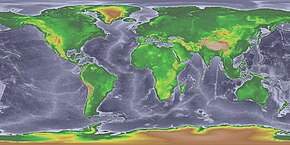
Back غمر جليدي ويسكونسن Arabic Wisconsin (geologie) Czech Wisconsini jäätumine ET Wisconsin-jääkausi Finnish ウィスコンシン氷期 Japanese Glaciação do Wisconsin Portuguese Висконсинское оледенение Russian Вісконсинське зледеніння Ukrainian

The Wisconsin glaciation, also called the Wisconsin glacial episode, was the most recent glacial period of the North American ice sheet complex, peaking more than 20,000 years ago. This advance included the Cordilleran Ice Sheet, which nucleated in the northern North American Cordillera; the Innuitian ice sheet, which extended across the Canadian Arctic Archipelago; the Greenland ice sheet; and the massive Laurentide Ice Sheet,[1] which covered the high latitudes of central and eastern North America. This advance was synchronous with global glaciation during the last glacial period, including the North American alpine glacier advance, known as the Pinedale glaciation. The Wisconsin glaciation extended from about 75,000 to 11,000 years ago, between the Sangamonian Stage and the current interglacial, the Holocene. The maximum ice extent occurred about 25,000–21,000 years ago during the last glacial maximum, also known as the Late Wisconsin in North America.

This glaciation radically altered the geography north of the Ohio River, creating the Great Lakes. At the height of the Wisconsin Episode glaciation, the ice sheet covered most of Canada, the Upper Midwest, and New England, as well as parts of Idaho, Montana, and Washington. On Kelleys Island in Lake Erie, northern New Jersey and in New York City's Central Park,[2] the grooves left in rock by these glaciers can be easily observed. In southwestern Saskatchewan and southeastern Alberta a suture zone between the Laurentide and Cordilleran ice sheets formed the Cypress Hills, North America's northernmost point that remained south of the continental ice sheets. During much of the glaciation, sea level was low enough to permit land animals, including humans, to occupy Beringia (the Bering Land Bridge) and move between North America and Siberia. As the glaciers retreated, glacial lakes were breached in great glacial lake outburst floods such as the Kankakee Torrent, which reshaped the landscape south of modern Chicago as far as the Ohio and Mississippi Rivers.
- ^ Cite error: The named reference
Harris1997was invoked but never defined (see the help page). - ^ SERC Media; Glacial Grooves, Central Park; Image 14884 is a 208 by 173 pixel JPEG; Uploaded: Apr5 09; Wayne Powell, CUNY Brooklyn College; http://serc.carleton.edu/details/images/14884.html